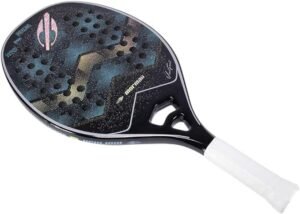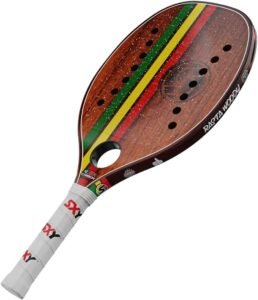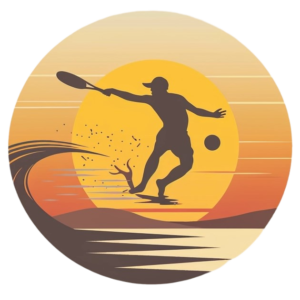Feeling battered by all the racket options? Not anymore.
Whether you’re just dipping your toes in the beach tennis waters or you’re a seasoned sandy warrior, we’re serving up a guide that’s more refreshing than iced lemonade after a heated match. In this beach tennis racket review we’ll help you crack the code as you discover not only what goes into making the perfect paddle, but what the best racket is for you specifically!
A Smashing Materials Selection
First things first, what your rackets are made of can make or break your beach tennis game. When deciding your paddle you have to consider the racket material trinity – carbon, fiberglass, and Kevlar.
If you’re just starting out, fiberglass is definitely your best option. It’s absorbent and elastic, which allows for a softer touch that helps minimize mistakes.

Moving up the ranks? After you’ve fully gotten into the swing of things you may want to move to a quality carbon fiber or Kevlar mixed racket. If you’re good enough to utilize the difference, these rackets will offer more power and control.

The secret here is flex – or the lack thereof. Fiberglass has it in spades, but as you progress you’ll be weaning off the flexi train and building some gumption for the rigidity express of carbon and Kevlar paddles.
In short, fiberglass is great for beginners through mid-intermediate because it allows for a softer touch (which helps minimize mistakes) and quality paddles are less expensive. However intermediate and advanced players are going to want to go with either carbon or Kevlar paddles which allow for more power and control of the ball.
Size Matters, Weigh Your Options
Beach tennis paddles generally stick to the dimensions of 50 cm length, 26 cm width, a thickness range between 19mm to 23mm, and weight between 300 – 350 grams. And just like Goldilocks, you need a racket that is “just right” for you.
You want control? Go thin and light. You want to blast balls like they’re out of a cannon? It’s all about that weight and girth.
A thinner and lighter paddle is like a scalpel – a precision instrument. These rackets allow for faster hand speed, more maneuverability and greater control of the ball.

Contrast that with heavy, thick rackets that are all about the statement – “Hulk Smash!” Heavier paddles offer significantly more power and stability than their lighter counterparts, but if you lack the strength and experience to wield them effectively it is going to come at the cost of that maneuverability offered by lighter paddles.

Ultimately it comes down to individual strength and preference, however it is generally recommended that beginners avoid starting out with a heavier paddle.
Surface Story
The surface of your beach tennis racket is another factor to consider when making your purchasing decision. Beginners can get away with a smooth surface, but intermediate and advanced players like it rough.
Rougher, textured surfaces give you more grip, and, most importantly, more spin. So if spin is something you want to incorporate into your game (and if you are playing at any sort of competitive level it is absolutely something you need to be doing) make sure it has a textured surface.
Balancing Act
Think of your racket as a sword; it needs the right balance to be wielded effectively.
The balance point of the racket is where the weight of the racket is balanced. A balance point at the center of the racket or closer to the handle allows for easier maneuverability and handling. This is best for all strokes or a “balanced” player, as well as players learning the game.
Contrast this with a balance point on the upper part of the racket. These rackets are made for power shots. The further up the racket, the more potential for power. But again, the tradeoff is that the higher up the racket the balance point is located, the less inherent ease of handling comes with the racket.
Summary
In summary, when it comes to choosing your perfect beach tennis racket, it’s all about finding the racket that’s right for you and your level and style of play.
Materials – If you are just learning the game consider a fiberglass option as they are less expensive and offer a softer touch for beginners. More intermediate and advanced players should look at carbon fiber or Kevlar as they offer more pop and control.
Size – Thinner paddles allow for greater control, thicker more power, and of course middle of the road offers a balance of each.
Weight – Whereas heavier rackets offer more power, lighter paddles allow for greater maneuverability and hand speed. It is recommended that new players avoid going too heavy straight away, but you should of course consider your own personal size and strength when making your decision.
Surface – A rougher surface allows for greater handling and the ability to add spin to the ball. A new player can get away with an entirely smooth surface, but intermediate and up all but need a textured surface to keep competitive.
Balance – A center or slightly closer to the handle balance point allows for easier maneuverability and handling. The higher up the racket your balance point, the more potential for power your shots will have, but you will
